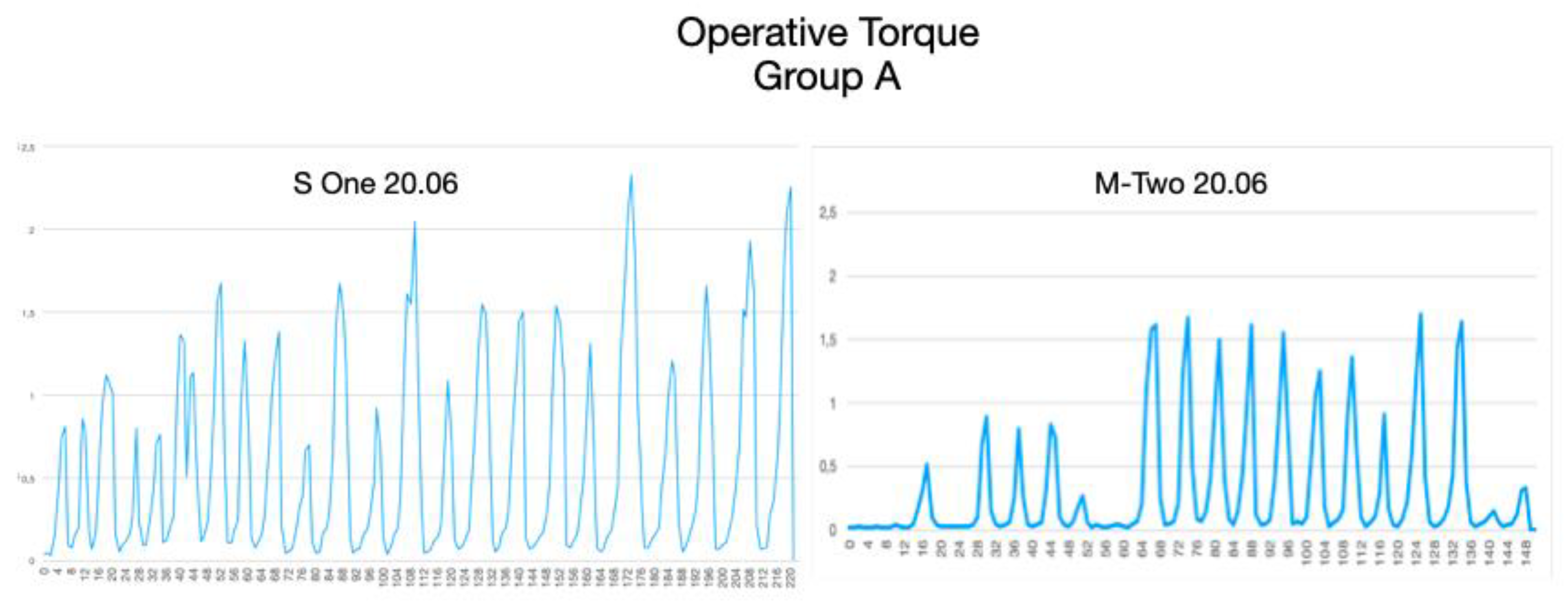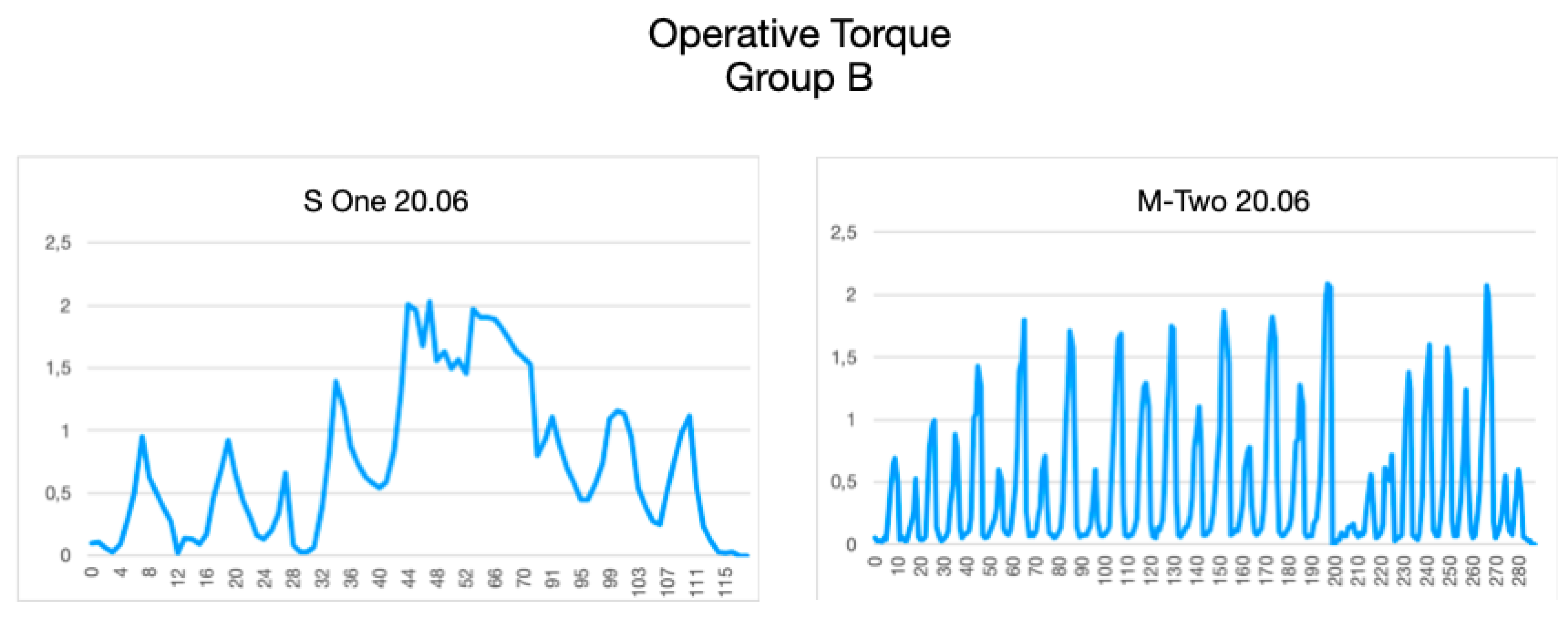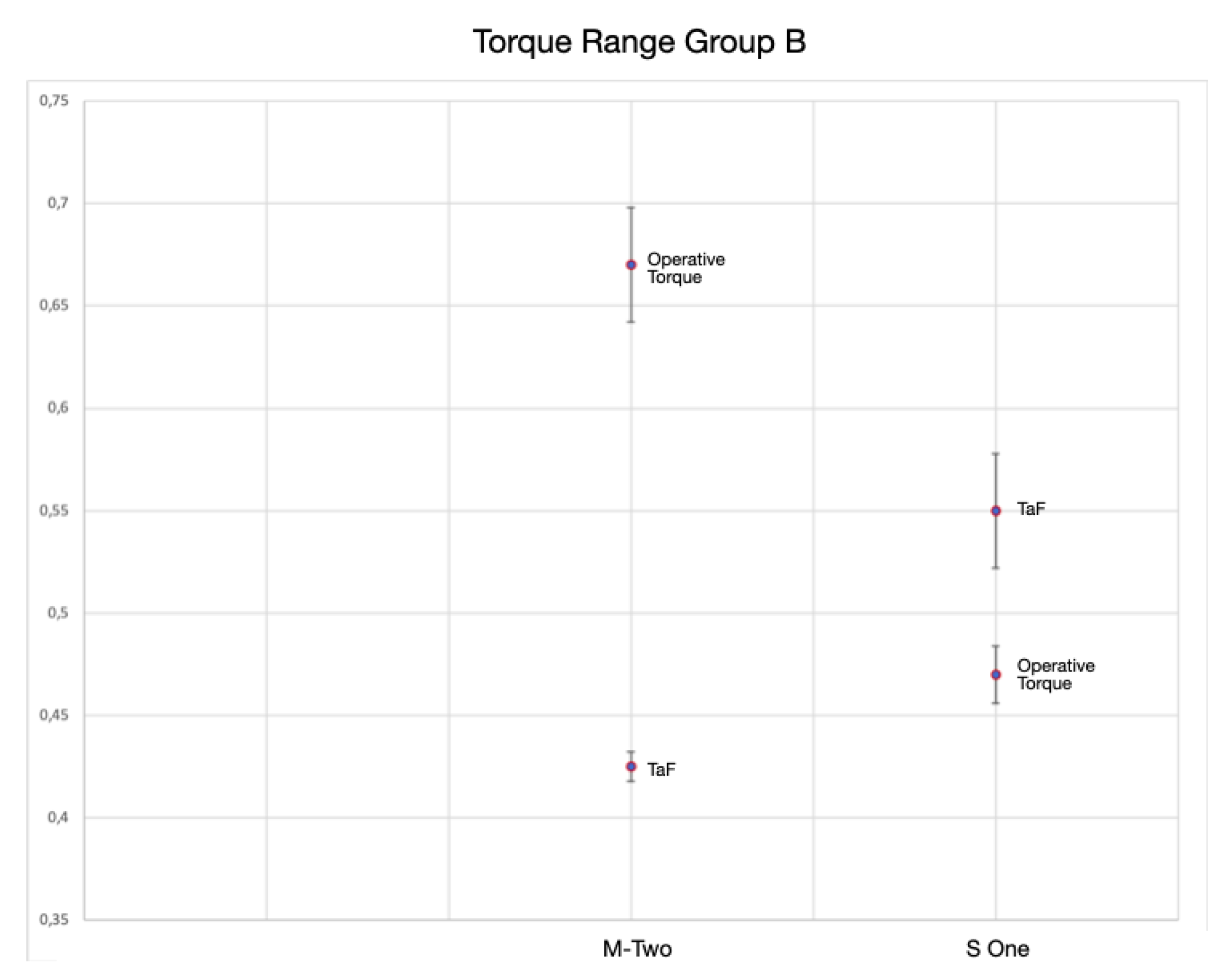Torque Range, a New Parameter to Evaluate New and Used Instrument Safety
Abstract
Featured Application
Abstract
1. Introduction
2. Materials and Methods
2.1. Operative Torque Tests
2.2. Torsional Resistance Test
2.3. Torque Range and Reduction of Torsional Resistance
2.4. Statistical analysis
3. Results
4. Discussion
5. Conclusions
Author Contributions
Funding
Conflicts of Interest
References
- Tabassum, S.; Zafar, K.; Umer, F. Nickel-Titanium Rotary File Systems: What’s New? Eur. Endod. J. 2019, 4, 111–117. [Google Scholar] [CrossRef]
- Di Nardo, D.; Galli, M.; Morese, A.; Seracchiani, M.; Ferri, V.; Miccoli, G.; Gambarini, G.; Testarelli, L. A comparative study of mechanical resistance of two reciprocating files. J. Clin. Exp. Dent. 2019, 11, e231–e235. [Google Scholar] [CrossRef]
- Gambarini, G.; Miccoli, G.; Seracchiani, M.; Morese, A.; Piasecki, L.; Gaimari, G.; Di Nardo, D.; Testarelli, L. Fatigue Resistance of New and Used Nickel-Titanium Rotary Instruments: A Comparative Study. Clin. Ter. 2018, 169, e96–e101. [Google Scholar]
- Sattapan, B.; Palamara, J.E.; Messer, H.H. Torque during canal instrumentation using rotary nickel-titanium files. J. Endod. 2000, 26, 156–160. [Google Scholar] [CrossRef] [PubMed]
- Htun, P.H.; Ebihara, A.; Maki, K.; Kimura, S.; Nishijo, M.; Tokita, D.; Okiji, T. Comparison of torque, force generation and canal shaping ability between manual and nickel-titanium glide path instruments in rotary and optimum glide path motion. Odontology 2020, 108, 188–193. [Google Scholar] [CrossRef] [PubMed]
- Santos, C.B.; Simoes-Carvalho, M.; Perez, R.; Vieira, V.T.L.; Antunes, H.S.; Cavalcante, D.F.; De-Deus, G.; Silva, E. Torsional fatigue resistance of R-Pilot and WaveOne Gold Glider NiTi glide path reciprocating systems. Int. Endod. J. 2019, 52, 874–879. [Google Scholar] [CrossRef] [PubMed]
- Gambarini, G.; Galli, M.; Seracchiani, M.; Di Nardo, D.; Versiani, M.A.; Piasecki, L.; Testarelli, L. In Vivo Evaluation of Operative Torque Generated by Two Nickel-Titanium Rotary Instruments during Root Canal Preparation. Eur. J. Dent. 2019, 13, 556–562. [Google Scholar] [CrossRef]
- Baratto-Filho, F.; de Freitas, J.V.; Gabardo, M.C.L.; Tomazinho, F.S.F.; Mazzi-Chaves, J.F.; de Sousa-Neto, M.D. Analysis of reciprocating system real-time torque variation during root canal preparation. BMC Res. Notes 2019, 12, 47. [Google Scholar] [CrossRef]
- Hashem, A.A.; Ghoneim, A.G.; Lutfy, R.A.; Foda, M.Y.; Omar, G.A. Geometric analysis of root canals prepared by four rotary NiTi shaping systems. J. Endod. 2012, 38, 996–1000. [Google Scholar] [CrossRef]
- Gambarini, G.; Miccoli, G.; D’Angelo, M.; Seracchiani, M.; Valenti Obino, F.; Reda, R.; Testarelli, L. The relevance of operative torque and torsional resistance of nickel-titanium rotary instruments: A preliminary clinical investigation. Saudi Endod. J. 2020. [Google Scholar] [CrossRef]
- Chiapasco, M. Manual of Oral Surgery, 5th ed.; Edra Edizioni: Milano, Italy, 2018. [Google Scholar]
- Gambarini, G.; Seracchiani, M.; Piasecki, L.; Valenti Obino, F.; Galli, M.; Di Nardo, D.; Testarelli, L. Measurement of torque generated during intracanal instrumentation in vivo. Int. Endod. J. 2019, 52, 737–745. [Google Scholar] [CrossRef] [PubMed]
- Inan, U.; Keskin, C. Torsional Resistance of ProGlider, Hyflex EDM, and One G Glide Path Instruments. J. Endod. 2019, 45, 1253–1257. [Google Scholar] [CrossRef] [PubMed]
- Garcia, P.R.; Resende, P.D.; Lopes, N.I.A.; Peixoto, I.; Buono, V.T.L.; Viana, A.C.D. Structural Characteristics and Torsional Resistance Evaluation of WaveOne and WaveOne Gold Instruments after Simulated Clinical Use. J. Endod. 2019, 45, 1041–1046. [Google Scholar] [CrossRef] [PubMed]
- Baek, S.H.; Lee, C.J.; Versluis, A.; Kim, B.M.; Lee, W.; Kim, H.C. Comparison of torsional stiffness of nickel-titanium rotary files with different geometric characteristics. J. Endod. 2011, 37, 1283–1286. [Google Scholar] [CrossRef] [PubMed]
- Plotino, G.; Grande, N.M.; Sorci, E.; Malagnino, V.A.; Somma, F. Influence of a brushing working motion on the fatigue life of NiTi rotary instruments. Int. Endod. J. 2007, 40, 45–51. [Google Scholar] [CrossRef] [PubMed]
- Foschi, F.; Nucci, C.; Montebugnoli, L.; Marchionni, S.; Breschi, L.; Malagnino, V.A.; Prati, C. SEM evaluation of canal wall dentine following use of Mtwo and ProTaper NiTi rotary instruments. Int. Endod. J. 2004, 37, 832–839. [Google Scholar] [CrossRef]
- Gambarini, G.; Miccoli, G.; Seracchiani, M.; Khrenova, T.; Donfrancesco, O.; D’Angelo, M.; Galli, M.; Di Nardo, D.; Testarelli, L. Role of the Flat-Designed Surface in Improving the Cyclic Fatigue Resistance of Endodontic NiTi Rotary Instruments. Materials 2019, 12, 2523. [Google Scholar] [CrossRef]
- Tokita, D.; Ebihara, A.; Nishijo, M.; Miyara, K.; Okiji, T. Dynamic Torque and Vertical Force Analysis during Nickel-titanium Rotary Root Canal Preparation with Different Modes of Reciprocal Rotation. J. Endod. 2017, 43, 1706–1710. [Google Scholar] [CrossRef]
- Gambarini, G.; Giansiracusa Rubini, A.; Sannino, G.; Di Giorgio, G.; Piasecki, L.; Al-Sudani, D.; Plotino, G.; Testarelli, L. Cutting efficiency of nickel-titanium rotary and reciprocating instruments after prolonged use. Odontology 2016, 104, 77–81. [Google Scholar] [CrossRef]
- Jamleh, A.; Alghaihab, A.; Alfadley, A.; Alfawaz, H.; Alqedairi, A.; Alfouzan, K. Cyclic Fatigue and Torsional Failure of EdgeTaper Platinum Endodontic Files at Simulated Body Temperature. J. Endod. 2019, 45, 611–614. [Google Scholar] [CrossRef]
- Kwak, S.W.; Lee, C.J.; Kim, S.K.; Kim, H.C.; Ha, J.H. Comparison of Screw-In Forces during Movement of Endodontic Files with Different Geometries, Alloys, and Kinetics. Materials 2019, 12, 1506. [Google Scholar] [CrossRef] [PubMed]



| Group A | Group B | p | Variation between the Group in Percentage | |
|---|---|---|---|---|
| S-One | 0.550 ± 0.010 aB | 0.470 ± 0.010 aD | 0.105 | −14.54% |
| M-Two | 0.345 ± 0.060 BC | 0.670 ± 0.020 CD | 0.022 | 194.20% |
| p | 0.043 | 0.012 |
| Group A | Group B | p | Amount of Reduction in Percentage | |
|---|---|---|---|---|
| S-One | 0.760 ± 0.010 AB | 0.550 ± 0.020 AD | 0.011 | 27.6% |
| M-Two | 0.645 ± 0.010 BC | 0.425 ± 0.010 CD | 0.001 | 34.1% |
| p | 0.009 | 0.026 |
| S-One | M-Two | |
|---|---|---|
| Group A | 0.210 | 0.300 |
| Group B | 0.08 | −0.245 |
© 2020 by the authors. Licensee MDPI, Basel, Switzerland. This article is an open access article distributed under the terms and conditions of the Creative Commons Attribution (CC BY) license (http://creativecommons.org/licenses/by/4.0/).
Share and Cite
Di Nardo, D.; Seracchiani, M.; Mazzoni, A.; Del Giudice, A.; Gambarini, G.; Testarelli, L. Torque Range, a New Parameter to Evaluate New and Used Instrument Safety. Appl. Sci. 2020, 10, 3418. https://doi.org/10.3390/app10103418
Di Nardo D, Seracchiani M, Mazzoni A, Del Giudice A, Gambarini G, Testarelli L. Torque Range, a New Parameter to Evaluate New and Used Instrument Safety. Applied Sciences. 2020; 10(10):3418. https://doi.org/10.3390/app10103418
Chicago/Turabian StyleDi Nardo, Dario, Marco Seracchiani, Alessandro Mazzoni, Andrea Del Giudice, Gianluca Gambarini, and Luca Testarelli. 2020. "Torque Range, a New Parameter to Evaluate New and Used Instrument Safety" Applied Sciences 10, no. 10: 3418. https://doi.org/10.3390/app10103418
APA StyleDi Nardo, D., Seracchiani, M., Mazzoni, A., Del Giudice, A., Gambarini, G., & Testarelli, L. (2020). Torque Range, a New Parameter to Evaluate New and Used Instrument Safety. Applied Sciences, 10(10), 3418. https://doi.org/10.3390/app10103418








